Abstract
The strategy of combining carbogen breathing and nicotinamide to overcome chronic and acute hypoxia respectively is being evaluated clinically. The effects of both agents individually and in combination on relative perfusion of 400-700 mm3 RIF-1 tumours and normal tissues were measured by 86Rb extraction. Carbogen breathing alone for 6 min increased relative tumour perfusion by 50-70% compared with control at flow rates of 50 to 200 ml min-1, but the effect was lost at 300 ml min-1. All flow rates also produced similar increases in relative perfusion of lung, of between 36% and 58%, and smaller increases in skin, of between 20% and 34%. The minimum breathing time at 150 ml min-1 to produce a significant increase in relative tumour perfusion was 4.5 min, and the effect was maintained up to 9 min. Nicotinamide alone at 1000 mg kg-1 60 min before assay did not alter relative tumour perfusion. Comparing the combination of nicotinamide with 6 min carbogen breathing at 150 ml min-1 with carbogen breathing alone showed no difference in relative tumour perfusion; increases were of 36% and 42% respectively. Nicotinamide-induced alterations in microcirculation associated with reduction of acute hypoxia have therefore not been detected by 86Rb extraction. The perfusion-enhancing effect of carbogen in this tumour is probably an important component of its radiosensitising ability, in addition to its known ability to increase the oxygen-carrying capacity of the blood, and should be taken into consideration in clinical studies.
Full text
PDF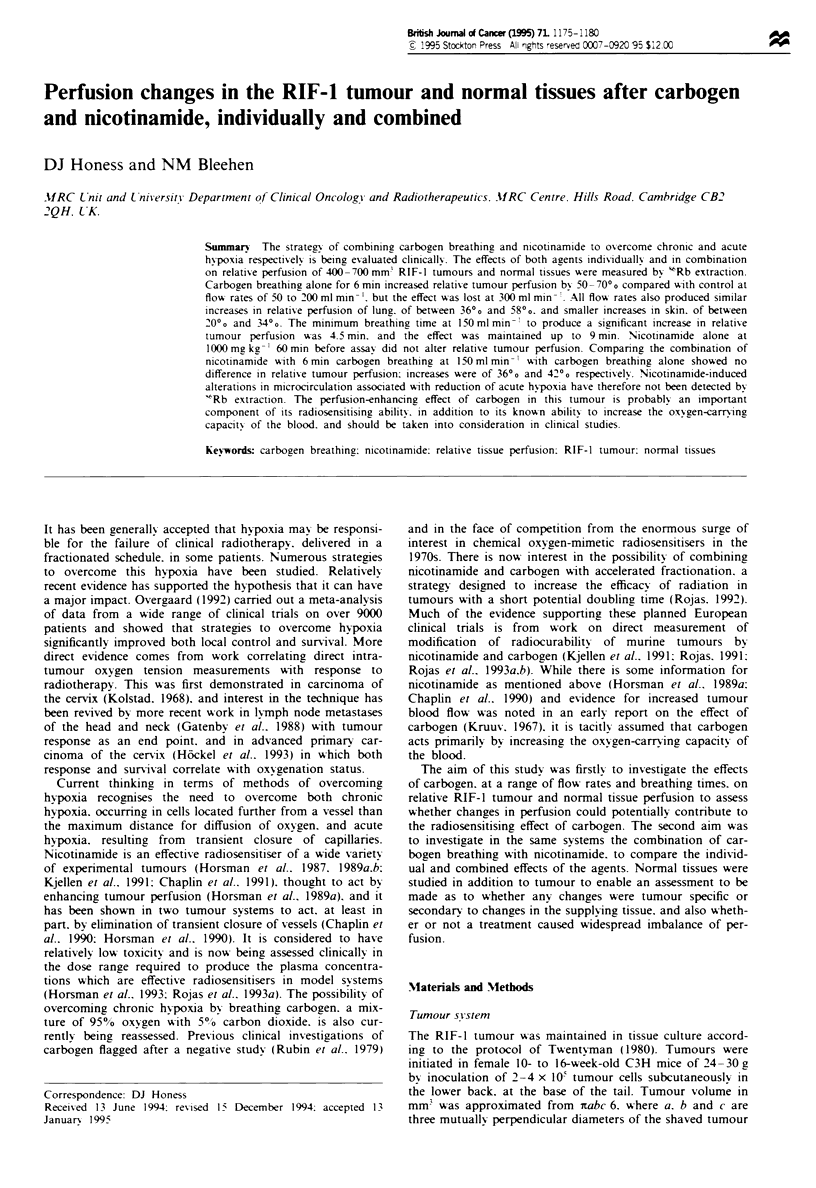
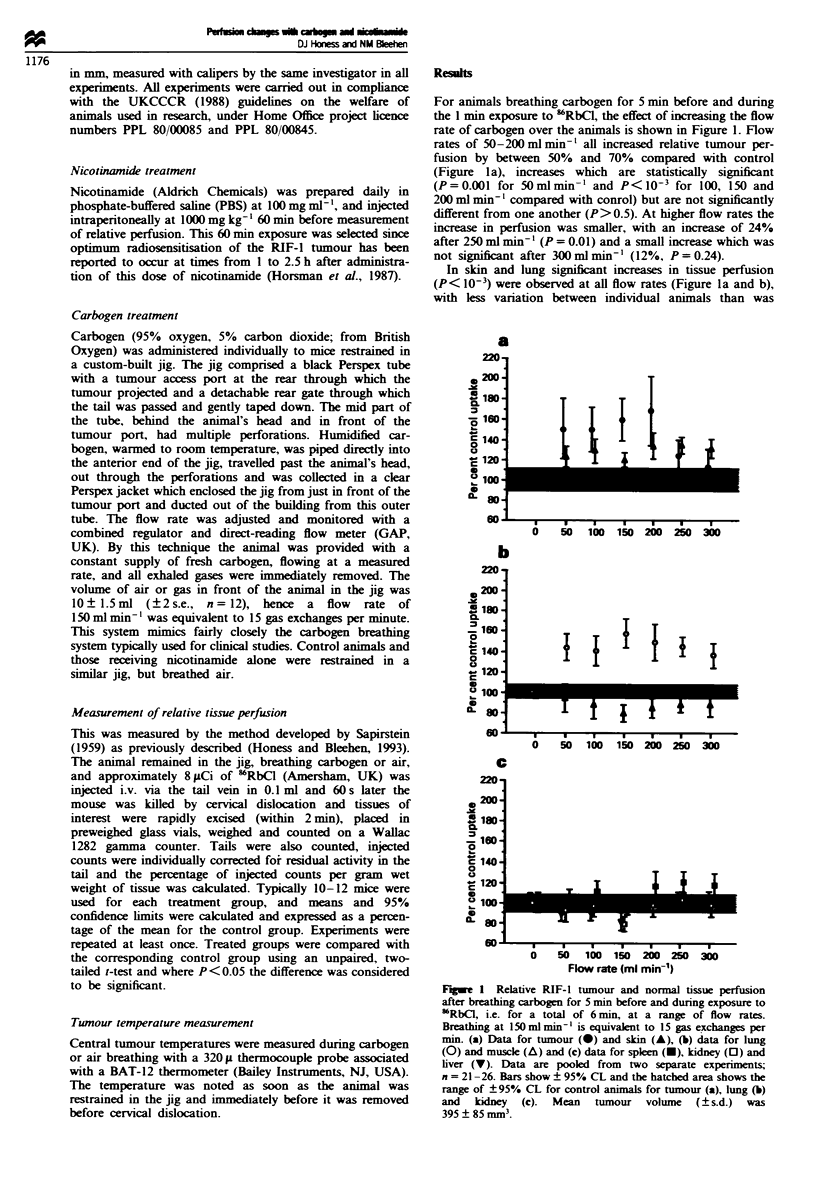
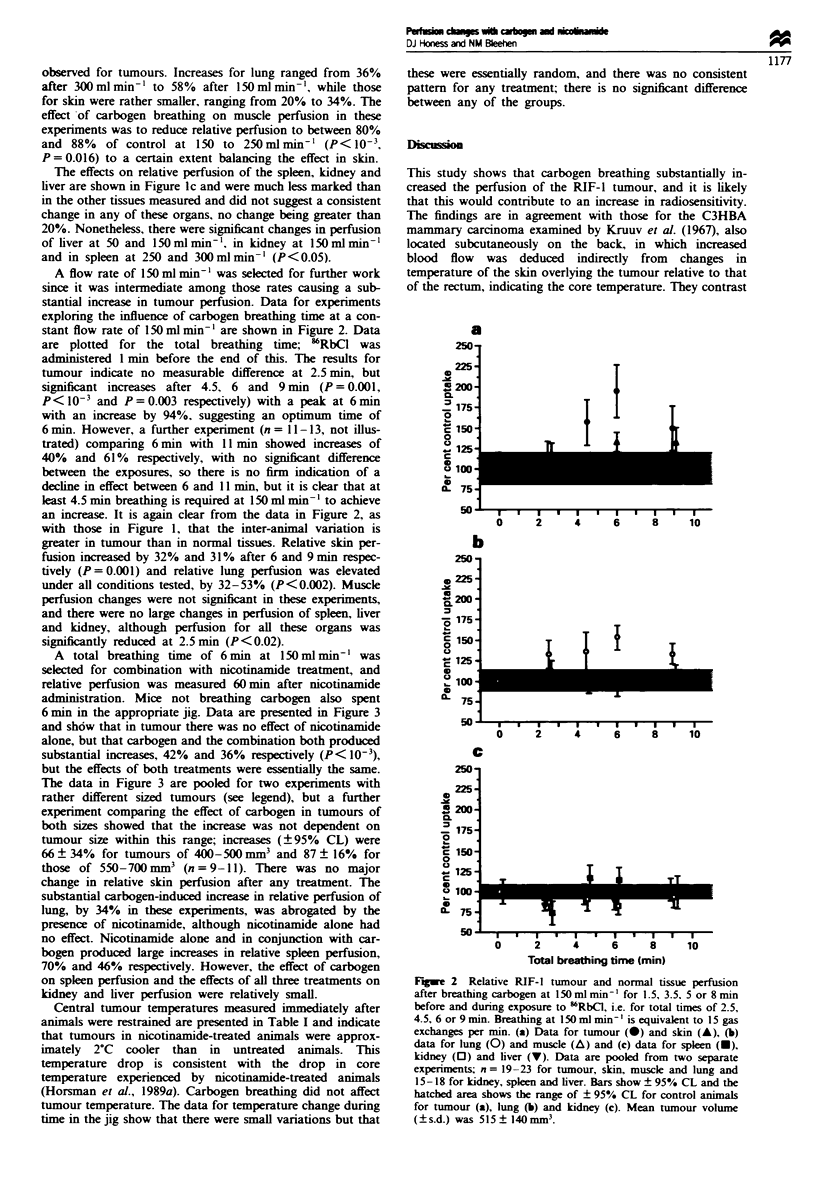
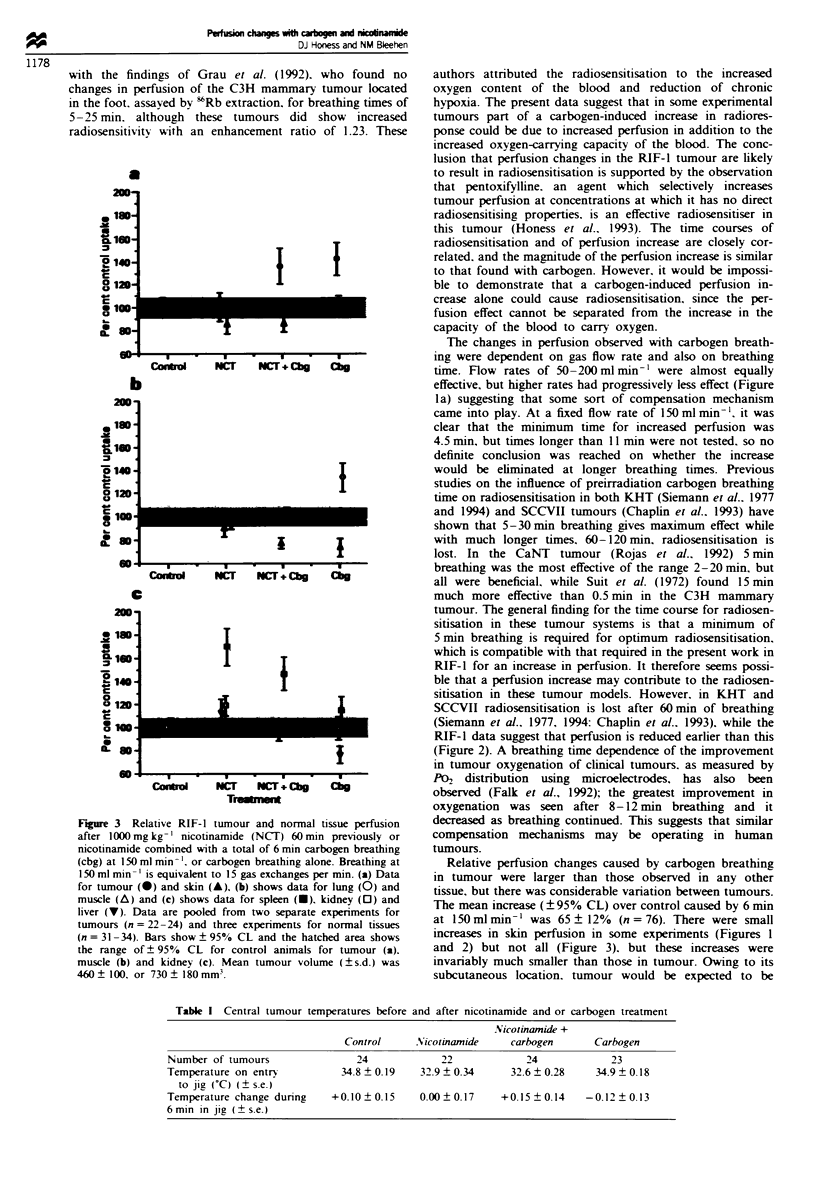
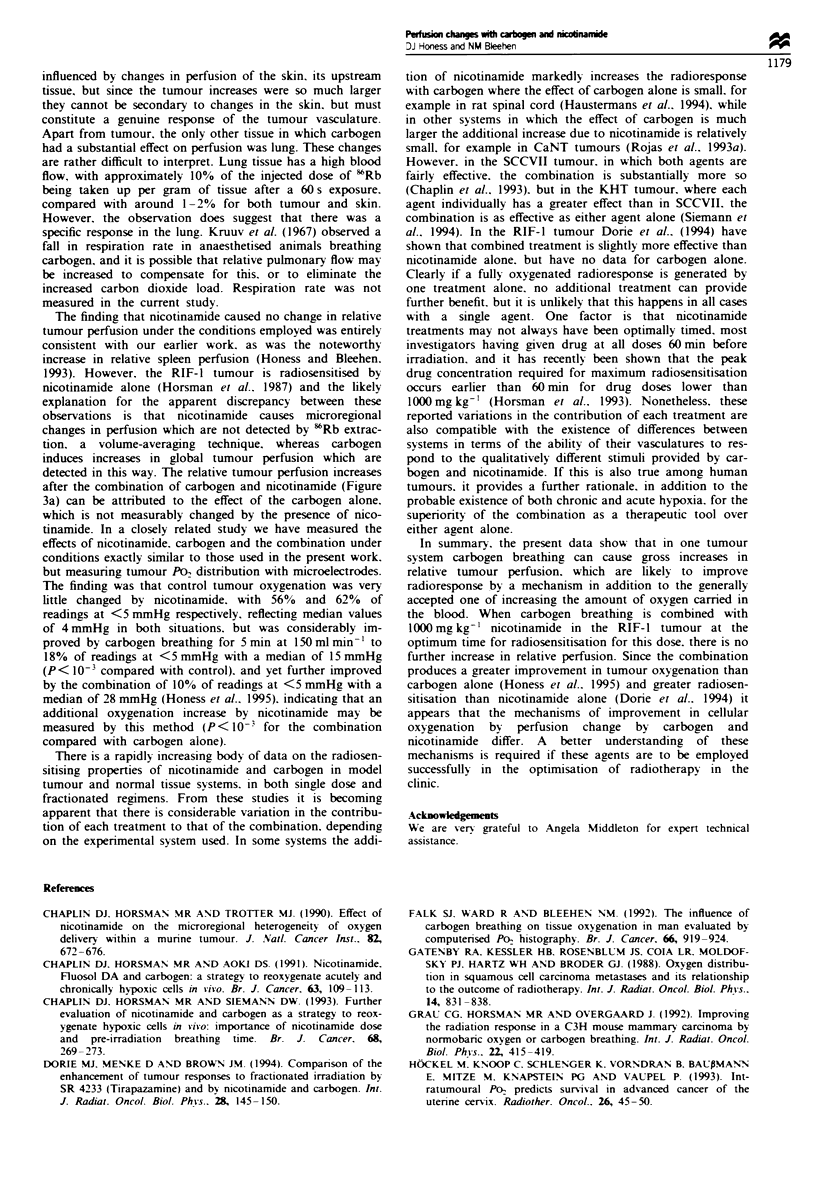
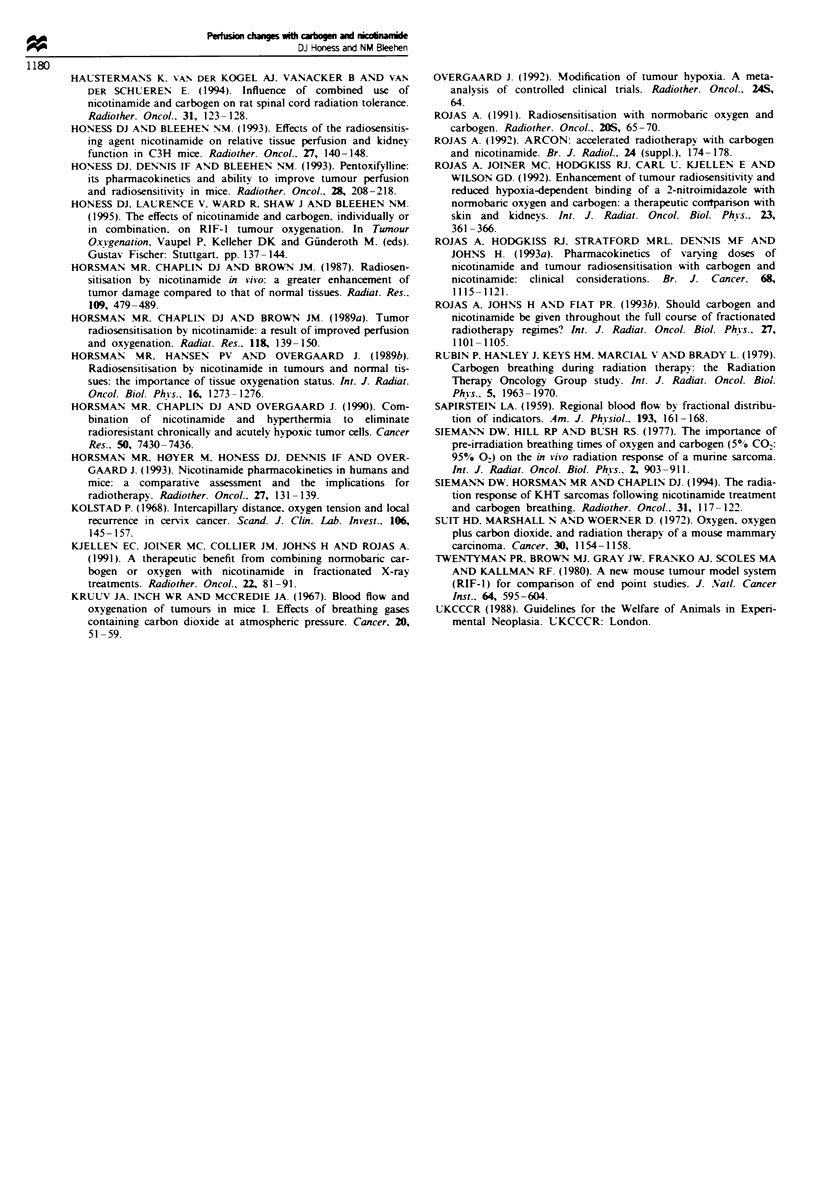
Selected References
These references are in PubMed. This may not be the complete list of references from this article.
- Chaplin D. J., Horsman M. R., Aoki D. S. Nicotinamide, Fluosol DA and Carbogen: a strategy to reoxygenate acutely and chronically hypoxic cells in vivo. Br J Cancer. 1991 Jan;63(1):109–113. doi: 10.1038/bjc.1991.22. [DOI] [PMC free article] [PubMed] [Google Scholar]
- Chaplin D. J., Horsman M. R., Siemann D. W. Further evaluation of nicotinamide and carbogen as a strategy to reoxygenate hypoxic cells in vivo: importance of nicotinamide dose and pre-irradiation breathing time. Br J Cancer. 1993 Aug;68(2):269–273. doi: 10.1038/bjc.1993.326. [DOI] [PMC free article] [PubMed] [Google Scholar]
- Chaplin D. J., Horsman M. R., Trotter M. J. Effect of nicotinamide on the microregional heterogeneity of oxygen delivery within a murine tumor. J Natl Cancer Inst. 1990 Apr 18;82(8):672–676. doi: 10.1093/jnci/82.8.672. [DOI] [PubMed] [Google Scholar]
- Dorie M. J., Menke D., Brown J. M. Comparison of the enhancement of tumor responses to fractionated irradiation by SR 4233 (tirapazamine) and by nicotinamide with carbogen. Int J Radiat Oncol Biol Phys. 1994 Jan 1;28(1):145–150. doi: 10.1016/0360-3016(94)90152-x. [DOI] [PubMed] [Google Scholar]
- Falk S. J., Ward R., Bleehen N. M. The influence of carbogen breathing on tumour tissue oxygenation in man evaluated by computerised p02 histography. Br J Cancer. 1992 Nov;66(5):919–924. doi: 10.1038/bjc.1992.386. [DOI] [PMC free article] [PubMed] [Google Scholar]
- Gatenby R. A., Kessler H. B., Rosenblum J. S., Coia L. R., Moldofsky P. J., Hartz W. H., Broder G. J. Oxygen distribution in squamous cell carcinoma metastases and its relationship to outcome of radiation therapy. Int J Radiat Oncol Biol Phys. 1988 May;14(5):831–838. doi: 10.1016/0360-3016(88)90002-8. [DOI] [PubMed] [Google Scholar]
- Grau C., Horsman M. R., Overgaard J. Improving the radiation response in a C3H mouse mammary carcinoma by normobaric oxygen or carbogen breathing. Int J Radiat Oncol Biol Phys. 1992;22(3):415–419. doi: 10.1016/0360-3016(92)90844-8. [DOI] [PubMed] [Google Scholar]
- Haustermans K., van der Kogel A. J., Vanacker B., van der Schueren E. Influence of combined use of nicotinamide and carbogen on rat spinal cord radiation tolerance. Radiother Oncol. 1994 May;31(2):123–128. doi: 10.1016/0167-8140(94)90392-1. [DOI] [PubMed] [Google Scholar]
- Honess D. J., Bleehen N. M. Effects of the radiosensitising agent nicotinamide on relative tissue perfusion and kidney function in C3H mice. Radiother Oncol. 1993 May;27(2):140–148. doi: 10.1016/0167-8140(93)90134-t. [DOI] [PubMed] [Google Scholar]
- Honess D. J., Dennis I. F., Bleehen N. M. Pentoxifylline: its pharmacokinetics and ability to improve tumour perfusion and radiosensitivity in mice. Radiother Oncol. 1993 Sep;28(3):208–218. doi: 10.1016/0167-8140(93)90060-l. [DOI] [PubMed] [Google Scholar]
- Horsman M. R., Chaplin D. J., Brown J. M. Radiosensitization by nicotinamide in vivo: a greater enhancement of tumor damage compared to that of normal tissues. Radiat Res. 1987 Mar;109(3):479–489. [PubMed] [Google Scholar]
- Horsman M. R., Chaplin D. J., Brown J. M. Tumor radiosensitization by nicotinamide: a result of improved perfusion and oxygenation. Radiat Res. 1989 Apr;118(1):139–150. [PubMed] [Google Scholar]
- Horsman M. R., Chaplin D. J., Overgaard J. Combination of nicotinamide and hyperthermia to eliminate radioresistant chronically and acutely hypoxic tumor cells. Cancer Res. 1990 Dec 1;50(23):7430–7436. [PubMed] [Google Scholar]
- Horsman M. R., Hansen P. V., Overgaard J. Radiosensitization by nicotinamide in tumors and normal tissues: the importance of tissue oxygenation status. Int J Radiat Oncol Biol Phys. 1989 May;16(5):1273–1276. doi: 10.1016/0360-3016(89)90297-6. [DOI] [PubMed] [Google Scholar]
- Horsman M. R., Høyer M., Honess D. J., Dennis I. F., Overgaard J. Nicotinamide pharmacokinetics in humans and mice: a comparative assessment and the implications for radiotherapy. Radiother Oncol. 1993 May;27(2):131–139. doi: 10.1016/0167-8140(93)90133-s. [DOI] [PubMed] [Google Scholar]
- Höckel M., Knoop C., Schlenger K., Vorndran B., Baussmann E., Mitze M., Knapstein P. G., Vaupel P. Intratumoral pO2 predicts survival in advanced cancer of the uterine cervix. Radiother Oncol. 1993 Jan;26(1):45–50. doi: 10.1016/0167-8140(93)90025-4. [DOI] [PubMed] [Google Scholar]
- Kjellen E., Joiner M. C., Collier J. M., Johns H., Rojas A. A therapeutic benefit from combining normobaric carbogen or oxygen with nicotinamide in fractionated X-ray treatments. Radiother Oncol. 1991 Oct;22(2):81–91. doi: 10.1016/0167-8140(91)90002-x. [DOI] [PubMed] [Google Scholar]
- Kolstad P. Intercapillary distance, oxygen tension and local recurrence in cervix cancer. Scand J Clin Lab Invest Suppl. 1968;106:145–157. [PubMed] [Google Scholar]
- Kruuv J. A., Inch W. R., McCredie J. A. Blood flow and oxygenation of tumors in mice. I. Effects of breathing gases containing carbon dioxide at atmospheric pressure. Cancer. 1967 Jan;20(1):51–59. doi: 10.1002/1097-0142(1967)20:1<51::aid-cncr2820200108>3.0.co;2-d. [DOI] [PubMed] [Google Scholar]
- Rojas A. M., Johns H., Fiat P. R. Should carbogen and nicotinamide be given throughout the full course of fractionated radiotherapy regimens? Int J Radiat Oncol Biol Phys. 1993 Dec 1;27(5):1101–1105. doi: 10.1016/0360-3016(93)90530-9. [DOI] [PubMed] [Google Scholar]
- Rojas A. ARCON: accelerated radiotherapy with carbogen and nicotinamide. BJR Suppl. 1992;24:174–178. [PubMed] [Google Scholar]
- Rojas A., Hodgkiss R. J., Stratford M. R., Dennis M. F., Johns H. Pharmacokinetics of varying doses of nicotinamide and tumour radiosensitisation with carbogen and nicotinamide: clinical considerations. Br J Cancer. 1993 Dec;68(6):1115–1121. doi: 10.1038/bjc.1993.490. [DOI] [PMC free article] [PubMed] [Google Scholar]
- Rojas A., Joiner M. C., Hodgkiss R. J., Carl U., Kjellen E., Wilson G. D. Enhancement of tumor radiosensitivity and reduced hypoxia-dependent binding of a 2-nitroimidazole with normobaric oxygen and carbogen: a therapeutic comparison with skin and kidneys. Int J Radiat Oncol Biol Phys. 1992;23(2):361–366. doi: 10.1016/0360-3016(92)90754-6. [DOI] [PubMed] [Google Scholar]
- Rojas A. Radiosensitization with normobaric oxygen and carbogen. Radiother Oncol. 1991;20 (Suppl 1):65–70. doi: 10.1016/0167-8140(91)90190-r. [DOI] [PubMed] [Google Scholar]
- Rubin P., Hanley J., Keys H. M., Marcial V., Brady L. Carbogen breathing during radiation therapy-the Radiation Therapy Oncology Group Study. Int J Radiat Oncol Biol Phys. 1979 Nov-Dec;5(11-12):1963–1970. doi: 10.1016/0360-3016(79)90946-5. [DOI] [PubMed] [Google Scholar]
- SAPIRSTEIN L. A. Regional blood flow by fractional distribution of indicators. Am J Physiol. 1958 Apr;193(1):161–168. doi: 10.1152/ajplegacy.1958.193.1.161. [DOI] [PubMed] [Google Scholar]
- Siemann D. W., Hill R. P., Bush R. S. The importance of the pre-irradiation breathing times of oxygen and carbogen (5% CO2: 95% O2) on the in vivo radiation response of a murine sarcoma. Int J Radiat Oncol Biol Phys. 1977 Sep-Oct;2(9-10):903–911. doi: 10.1016/0360-3016(77)90188-2. [DOI] [PubMed] [Google Scholar]
- Siemann D. W., Horsman M. R., Chaplin D. J. The radiation response of KHT sarcomas following nicotinamide treatment and carbogen breathing. Radiother Oncol. 1994 May;31(2):117–122. doi: 10.1016/0167-8140(94)90391-3. [DOI] [PubMed] [Google Scholar]
- Suit H. D., Marshall N., Woerner D. Oxygen, oxygen plus carbon dioxide, and radiation therapy of a mouse mammary carcinoma. Cancer. 1972 Nov;30(5):1154–1158. doi: 10.1002/1097-0142(197211)30:5<1154::aid-cncr2820300503>3.0.co;2-5. [DOI] [PubMed] [Google Scholar]
- Twentyman P. R., Brown J. M., Gray J. W., Franko A. J., Scoles M. A., Kallman R. F. A new mouse tumor model system (RIF-1) for comparison of end-point studies. J Natl Cancer Inst. 1980 Mar;64(3):595–604. [PubMed] [Google Scholar]


